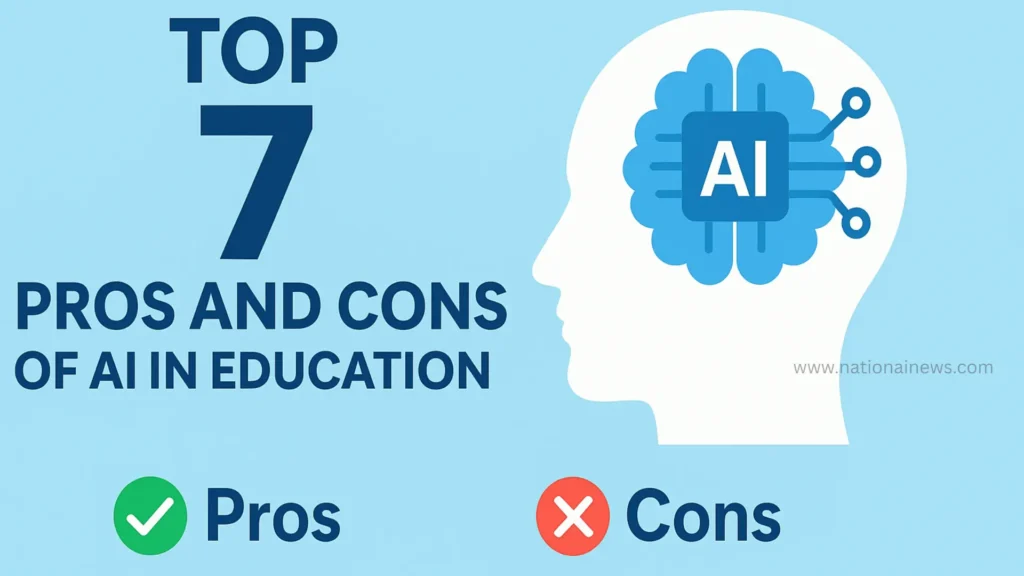Explore Top 7 Pros and Cons of AI in Education. Learn how AI enhances learning, its drawbacks, and future impact on schools and universities

Artificial Intelligence (AI) is becoming a vital part of our daily lives, and education is no exception. While many see the benefits of AI in schools and universities, others raise valid concerns. This article explores the pros and cons of AI in education, helping you understand its role, benefits, drawbacks, and future implications.
Understanding the pros and cons of AI in education helps schools make smarter tech decisions. Exploring the pros and cons of AI in education reveals its impact on learning, teaching, and future growth.
What is Artificial Intelligence in Education?
Artificial Intelligence in education refers to using smart computer systems to enhance learning. These systems can adapt to each student’s pace, provide real-time feedback, automate tasks, and support teachers in new and innovative ways. The pros and cons of AI in education highlight both innovation and challenges.
AI tools often use natural language processing, machine learning, and data analytics to personalize educational content and streamline teaching. From virtual tutors to intelligent grading software, AI is changing how we learn and teach.
Before adopting new tools, educators should weigh the pros and cons of AI in education carefully.
Also Read: Top AI Jobs Hiring in Demand | Best 5 Career Options in AI
Pros of AI in Education
1. Personalized Learning
AI in educational content to fit each student’s unique learning style in classroom, strengths, and weaknesses. This personalization helps improve learning efficiency and ensures that no student is left behind. Unlike traditional educational methods, AI adjusts in real time classroom to suit individual needs.
2. Immersive Learning
AI-driven tools such as Augmented Reality (AR) and Virtual Reality (VR) create engaging and interactive environments. These tools allow students to explore historical events, conduct virtual science experiments, or visualize complex concepts, making learning more enjoyable and effective.
3. Better Student Engagement
Gamified AI platforms use rewards, challenges, and interactive feedback to boost motivation. Students stay more focused and active in their lessons when they are part of a dynamic and responsive system. This approach can lead to improved academic performance. The pros and cons of AI in education shape how technology transforms the classroom experience.
4. Cost-Effective Solutions
By automating administrative tasks like grading and scheduling, AI allows schools to save time and reduce operational costs. It also allows for large-scale online learning, making quality education more affordable and accessible to a broader audience.
5. Intelligent Tutoring Systems
These AI systems provide personalized tutoring to students, mimicking one-on-one instruction. They identify learning gaps and offer targeted exercises, helping students progress at their own pace while receiving instant support.
6. Real-Time Evaluation
AI tools continuously track student progress and provide immediate feedback. Teachers can use this data to intervene early, adjust instruction methods, and provide extra help where needed, resulting in better academic outcomes.
7. Higher Academic Standards
AI brings consistency to grading and instructional quality. It enables teachers to design better curricula based on student performance data, ensuring that educational standards remain high across different schools and regions. AI in education promotes higher academic standards by offering data-driven insights, though understanding the pros and cons of AI in education remains essential.
Also Read: Discover What Jobs Will AI Not Replace | TOP 10 Safe AI Jobs
Cons of AI in Education
1. Privacy Issues
AI systems collect large amounts of data, including personal, academic, and behavioral information. Without strong data protection policies, there is a risk of data leaks, misuse, or unauthorized access, raising ethical and legal concerns.
2. Dependence on Technology
As schools increasingly rely on AI, there is a growing risk of overdependence. When technical issues arise or systems fail, learning can be disrupted. This dependency may also discourage students from developing problem-solving skills without technological aid.
3. Lack of Human Interaction
AI cannot replicate human empathy, understanding, and emotional support. Students still need real teachers to provide encouragement, mentorship, and social interaction, which are essential parts of the learning process. Despite the benefits, the pros and cons of AI in education include reduced emotional connection and human mentorship in the classroom.
4. Increased Risk of Cheating
Some AI tools can be misused by students to cheat, such as using AI-generated content for assignments. This makes it harder for educators to detect dishonesty and evaluate students’ true capabilities.
5. Teacher Job Displacement
AI may reduce the need for certain educational roles, especially in grading, content delivery, and administration. While it aims to assist teachers, some fear it might eventually replace human educators in some tasks, affecting employment opportunities.
How to Use AI Effectively in Schools
To make AI successful in education:
- Set clear goals
- Train teachers regularly
- Build strong infrastructure
- Monitor and evaluate AI Tools regularly
Involving educators and students in the process ensures smoother adoption and better results.
Future of AI in Education
The future looks promising. AI will continue to personalize learning, simplify tasks, and make education more inclusive. With tools like speech-to-text and real-time translation, students with disabilities or language barriers can learn effectively.
However, it’s important to balance AI with human oversight. Ethical concerns like bias, fairness, and transparency must be addressed.
Conclusion: Pros and Cons of AI in Education
AI is transforming education for the better – but not without challenges. While it improves learning experiences and makes education more accessible, it also raises concerns about privacy, ethics, and the human role in learning. The key lies in using AI responsibly and keeping educators at the heart of education.
